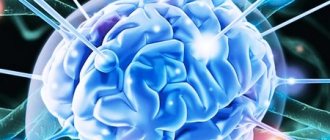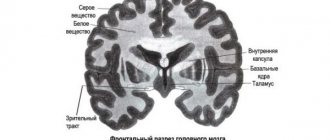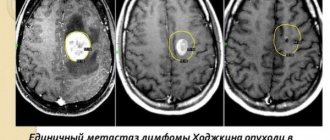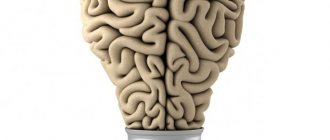What is BAK?
Bioacoustic correction (BAC) is an innovative method of influencing brain structures using a special computer program that can convert brain signals obtained from a person’s electroencephalogram into sound.
During the session, the patient literally listens to the “programmed music” of his brain. But the most important thing is that with the reverse effect of sound on the neurons of the brain, involuntary self-regulation of the body occurs, which can be observed in real time using an electroencephalogram. Bioacoustic brain correction combines the latest technologies of neurotherapy and biofeedback. Bioacoustic correction, being an effective, non-invasive and non-drug method of rehabilitation of patients used at the CORTEX medical center. It is aimed at restoring the functional state of the central nervous system and mobilizing the body’s natural reserves, helps to increase the effectiveness of medical rehabilitation in complex therapy with biophysical activation of neuromotor structures, and can be used independently for a number of diseases.
Is this method effective?
The effectiveness of the method has been confirmed:
- 25 years of scientific research at the Federal State Budgetary Institution “Research Institute of Experimental Medicine”, Northwestern Branch of the Russian Academy of Medical Sciences (FGBU “NIIEM” NW RAMS), Northwestern State Medical University named after. I.I. Mechnikov, State Institute for Advanced Training of Doctors of the Ministry of Defense of the Russian Federation, St. Petersburg State Pediatric Academy, Russian Scientific Center for Medical Rehabilitation and Balneology of the Ministry of Health of the Russian Federation;
- Clinical trials and medical practice at: State Research Institute of Emergency Medicine named after. N.V. Sklifosovsky, No. 2 FBU “3 TsVKG im. A.A. Vishnevsky Ministry of Defense of Russia", MAPO (St. Petersburg), State Autonomous Institution of the Republic of Tatarstan Emergency Hospital (Regional Vascular Center) Tatarstan and in a number of other leading clinics in Moscow and St. Petersburg;
- The research results are presented in scientific articles and defended in dissertations.
Benefits of treatment
The bioacoustic method has a number of advantages, which include:
- No addiction or unwanted effects.
- During bioacoustic correction of the brain, the patient does not need adaptation.
- With the help of manipulation, non-invasive and non-drug treatment is provided.
- The therapy has been used for more than 25 years, during which its effectiveness has been repeatedly confirmed.
- When using the bioacoustic correction method, an individual approach is provided. The impact is carried out by a signal that preliminarily coordinates the endogenous activity of the patient’s brain in real time.
- It is allowed to combine the bak method with other therapeutic techniques, which ensures an increase in their effectiveness. With the use of therapy, the drug load is reduced or completely eliminated.
- Therapy is characterized by targeted action. The signal operates at the site of detection of pathology using the method of direct influence on neurons.
- Provides the ability to regulate exposure online. The manipulation is controlled using EEG, which makes it possible to assess the effectiveness of therapy.
- Thanks to the involuntary impact, the activation of natural self-healing processes is ensured. Patient participation is not required.
- The procedure is absolutely painless and has a minimum number of contraindications, so both children and adult patients can be cured with its use.
The correction has a huge number of advantages, so it is used to treat patients in many medical centers.
In what areas of medicine is BAC used?
- Regenerative medicine and rehabilitation
- Neurology
- Psychiatry
- Narcology
- Cardiology
- Professional activities (including personnel of special risk units)
- Special (correctional) pedagogy (including oligophrenopedagogy and speech therapy)
- Sport
What is the essence of the method?
The LHC method is based on the concept of involuntary self-regulation. The content of this concept is not the compensation of impaired physiological functions, but the activation of natural regulatory processes that are normally carried out involuntarily, but were suppressed as a result of an unfavorable combination of environmental factors, illness or individual personal characteristics. Activation of self-regulation processes is carried out by acoustic stimulation consistent with the current bioelectrical activity of the brain. The presentation of music-like sounds, the parameters of which are consistent with the indicators of the rhythmic structure of the EEG and synchronous with the events of bioelectrical activity of the brain, creates unique conditions for adaptive stimulation. This type of sensory stimulation, which combines elements of biofeedback, audiovisual influence and music therapy, allows you to activate natural self-regulation processes, which contributes to the effective restoration of the functional state of the central nervous system.
The LHC method activates the structures of the mesolimbic system when listening to music by synchronizing the acoustic impact with the endogenous activity of the brain.
Mechanism of influence: stimulation of brain structures responsible for the processes of motivation and reinforcement - the limbic system (primarily the hypothalamic nuclei, amygdolar-hippocampal complex, etc.)
Basics and characteristics of the method
Bioacoustic correction, otherwise called BAC, is a proven method of treating many disorders in the central nervous system. The BAC technology is especially effective for children in whom bioacoustic correction of brain dysfunction is carried out for the treatment of neuroses and psychosomatic diseases - a group of diseases provoked not by organic, but by psychogenic causes.
The principle of the technique is based on the concept of reflex self-regulation. Exposure to the head area with a sound signal leads to the restoration of natural autoregulation functions. The supplied acoustic impulses are coordinated with bioelectrical brain activity. The sounds of the range discernible to the human ear are synchronized with the oscillatory electrical impulses of the brain and are in harmony with the frequency indicators of the electroencephalogram.
As a result, adaptive regulation of the functions of all parts of the brain is carried out. The method of hardware rehabilitation was developed by neurophysiologists of the Russian Academy of Medical Sciences. The research was carried out over 25 years. The effectiveness of the technology has been proven through scientific experiments. The BAK procedure is safe for children. A hardware-computer complex is used for this purpose.
What are the advantages of the LHC method?
- non-drug, non-invasive treatment of functional disorders of the central nervous system;
- no addiction, side effects and age restrictions;
- high efficiency proven by many years of use;
- compatibility and acceleration of other types of treatment (biophysical activation of neuromotor structures)
- reduction of drug load, for some nosologies the possibility of replacing drug treatment.
- Each LHC procedure is carried out under the control of EEG recording via 4 channels in on-line mode (review and indexometric analysis).
- after each procedure, it is possible to evaluate changes in various EEG parameters (indexometric, pattern, cross-correlation analyses).
How does LHC differ from classical biofeedback (BFB) methods?
- Possibility of use without age restrictions
- possibility of use in case of deficits in the cognitive and emotional-volitional spheres of mental activity
- complete and accurate display of EEG parameters in a sound image: - time-frequency - amplitude - spatial
- work in real time
- constant hardware conversion delay 20-30 ms
How does bioacoustic correction work?
The procedure algorithm is based on sensory EEG-dependent brain stimulation and is as follows:
- The patient sits comfortably in a chair and is completely calm. Using electrodes placed on the surface of the head, the electroencephalograph reads the biopotentials of nerve cells.
- Using a special device, electrical biopotential is converted into sound.
- Thanks to powerful speakers, the music of the brain is amplified and played to the patient in real time through headphones.
The duration of the procedure is 15-25 minutes. The full course of treatment consists of 7-15 sessions. Thus, all that bioacoustic correction of the brain requires is to relax and listen. If the procedure is performed on a child, it is better to use stereo headphones. During the correction, children are allowed to engage in quiet games. If the baby is capricious, it is advisable that the mother be nearby.
What is the essence of the therapeutic effect of exposure?
- restoration of the functional state of the central nervous system - normalization of electroencephalogram parameters
- normalization of psychophysiological and psychological indicators (improvement of psycho-emotional state, improved mood, increased activity, decreased emotional tension and fatigue, normalized sleep and appetite, decreased fixation on one’s condition, decreased indicators of neuroticism, depression, etc.);
- hemodynamic (central and autonomic regulation of the cardiorespiratory system, improvement of vascular reactivity, normalization of blood pressure, etc.);
- immunomodulatory;
- analgesic (tension headaches, functional headaches and anginal pains during angina pectoris and myocardial infarction, other types of pain); • metabolic-trophic;
- stimulating and restorative (stimulation of mental and speech development in children with delays in speech and psycho-speech development, effective restoration of speech and cognitive functions after organic brain damage, etc.)
What are the indications of the BAC method in pediatric neurology?
- Mental development disorders (mental retardation, mental retardation, autistic syndrome).
- Speech development disorders (dysarthria, dyslalia, OHP, alalia, dysgraphia, dyslexia).
- Attention deficit hyperactivity disorder.
- Neurosis-like disorders (tics, enuresis).
- Tension headaches. Migraine.
- Consequences of cerebrovascular accident, organic brain damage, traumatic brain injury.
- Hypoxemic-ischemic lesions of the central nervous system of perinatal origin
- Adaptation to school and preschool institutions.
- General health improvement of the body and psychoprophylaxis: increasing and maintaining the optimal level of adaptive capabilities of the body, the process of self-regulation.
Positive effects
The technique is aimed at restoring the natural processes of regulation of mental activity. Acoustic therapy is also used to improve the adaptive abilities of the brain, which can be useful for chronic stress and impaired control of emotions. The physiological effect of BAC is associated with the restoration of cellular potential and improvement of neural interactions in the brain.
Additional effects:
- Restructuring of cognitive activity aimed at eliminating any mental illness. The procedure demonstrates effectiveness for mood swings, depression, nervousness and other conditions.
- Restoring learning ability. This effect is especially useful for a child, since at an early age the nervous system retains a high degree of plasticity.
- Preservation of cognitive abilities against the background of progressive brain diseases. This effect is used in complex therapy of degenerative pathologies. Such exposure is necessary for adult patients with Alzheimer's disease and other types of dementia.
- Improvement of hemodynamic condition. Blood delivery to each part of the brain is enhanced. As a result, all cells receive sufficient oxygen and nutrients.
- Modulation of the immune system: BAK maintains the body’s protective functions and prevents the development of inflammatory processes in parts of the nervous system.
- Analgesic effect, useful for chronic tension headaches and migraines.
- Neuroendocrine regulation. The correct balance of neurotransmitters in the brain helps maintain cognitive abilities. BAK affects the centers for the production of mediators and eliminates the deficiency of serotonin, dopamine and other substances.
Thus, acoustic therapy improves brain function on several levels at once.
What are the indications for the LHC method in adult neurology?
- Relieving “chronic fatigue” syndrome. Eliminating the effects of stress. Post-traumatic stress. "Loss Syndrome"
- Treatment of neurotic, neurological disorders. Treatment of mental disorders (anxiety syndrome, phobic syndrome (panic attacks), astheno-depressive syndrome). Treatment of emotional disorders: anxiety, restlessness, increased irritability, fatigue, decreased performance, internal tension, decreased mood. Treatment of sleep and appetite disorders.
- Vegetative-vascular disorders (both diencephalic in nature and parasympathetic crises).
- Consequences of stroke, organic brain damage, traumatic brain injury: restoration of cognitive functions and speech disorders, normalization of psychophysiological status.
What contraindications should you keep in mind?
- acute postoperative period;
- hypertensive crisis;
- acute infectious diseases;
- acute disorders of cerebral and spinal circulation;
- myocardial infarction in the acute period;
- acute and subacute inflammatory diseases of the brain and spinal cord, its membranes (myelitis, meningitis, etc.);
- acute bleeding.
Pros and cons of welding
If we talk about the effectiveness of such tuning as welding, then it is practically zero. The only advantage of installing such wheels is the unusual appearance of the car. The welding looks especially impressive on lowered cars, in which you can partially hide the wheel under the cut arch. Such tuning can often be seen on cars that are intended exclusively for drifting, but not for everyday movement around the city.
There are many more disadvantages to welding, and many of them directly affect the technical characteristics of the car, which will affect its daily operation:
It's difficult to find the right set of tires. Boiled wheels of increased width require wide tires. Since such tires are not in demand, their price in car stores is quite high, and their prevalence on sale is low
Important: If you use narrow tires, this can lead to them “sliding” in a sharp turn, which is likely to provoke an accident.
Increased load on suspension elements. This is due to the high mass of welding
The load leads to accelerated wear of suspension components; Difficulty in installation. Not every tire shop will undertake the installation of welding on a car, much less do it correctly. These tires need to be inflated using the explosive method. The above are just some of the disadvantages. Also, depending on the weld design, other problems may arise. If the disk is not stamped at the factory, but welded from parts or by laying a metal strip, you need to make sure that all the seams are well welded and will not come apart over time, otherwise this will lead to “bleeding” of air.
Please note: A vehicle that has welding joints installed will not be able to undergo maintenance. Also, such cars attract much more attention from traffic police officers, and a car with welding marks can be sent to an impound lot if it is moving on public roads, and the driver can be fined
How is the procedure performed?
Headphones are put on the child, and sensors are attached to his head that read EEG parameters. After this, he begins to hear acoustic waves, which are essentially converted electrical signals from the brain. Each LHC procedure is carried out under the control of EEG recording via 4 channels online (review and indexometric analysis). After the procedure, the specialist has the opportunity to evaluate changes in various EEG parameters.
The duration of the procedure is 15-25 minutes, while the procedure is comfortable and the patient does not experience any painful sensations.
A positive effect is often noted already during the procedures or within 1-1.5 months.
Recommended course: from 7 to 15 sessions of 15-25 minutes. It is advisable to repeat this treatment after 2-3 months.
Areas of use
In cardiology, correction using the bioacoustic method is applicable in patients with arterial hypertension and as rehabilitation after myocardial infarction. Gastroenterologists use the method to treat colitis, gastritis and peptic ulcers, also using it to normalize appetite and eliminate irritable bowel syndrome.
In the field of pulmonology, treatment using bioacoustic correction is possible for bronchial asthma and chronic obstructive pulmonary disease. Dermatologists prescribe procedures for itching of various etiologies.
The practical implementation involves applying special sensors to the patient’s head. The readings are displayed on the device monitor. During the examination, the patient hears music through headphones, which is converted into acoustic sound.











